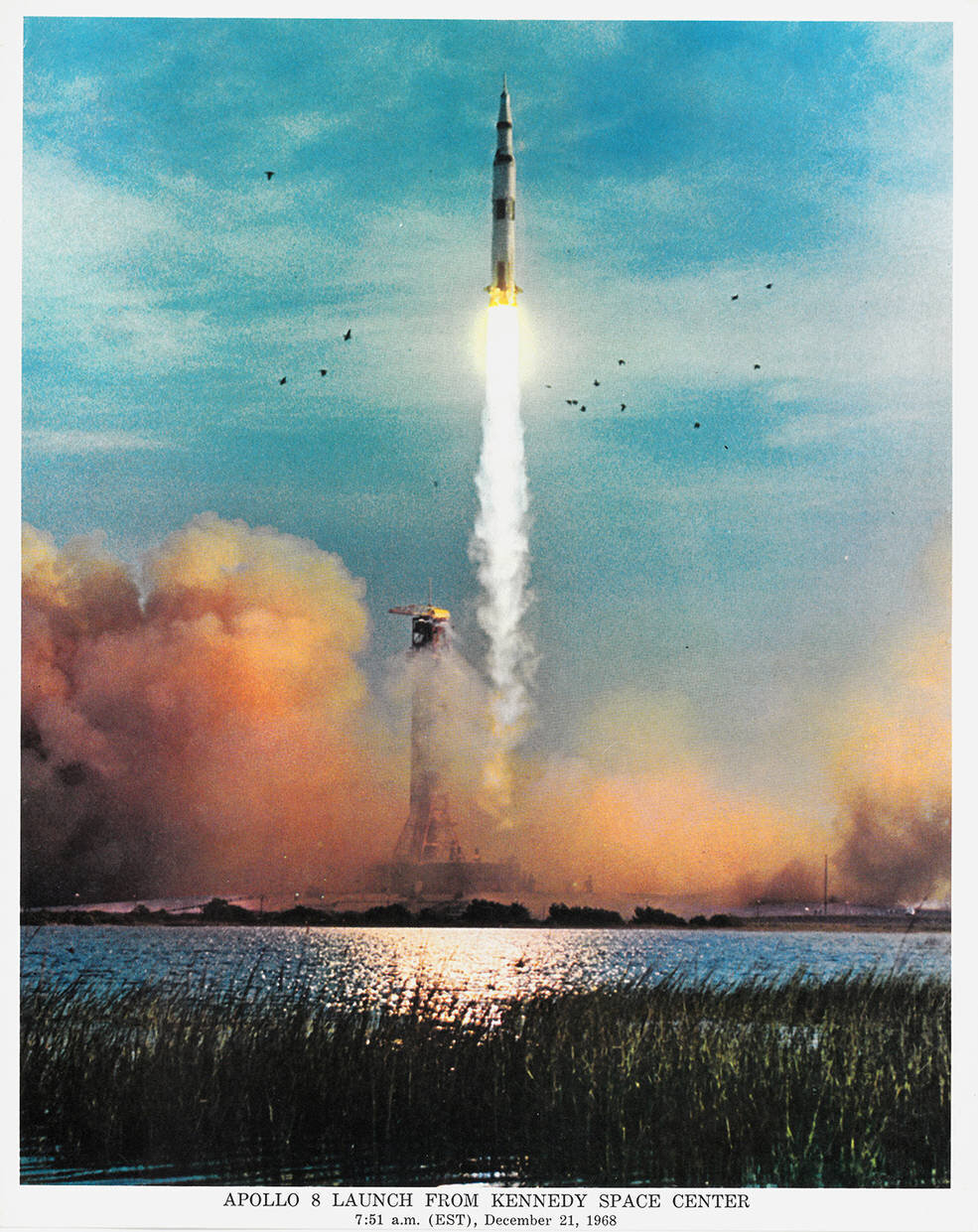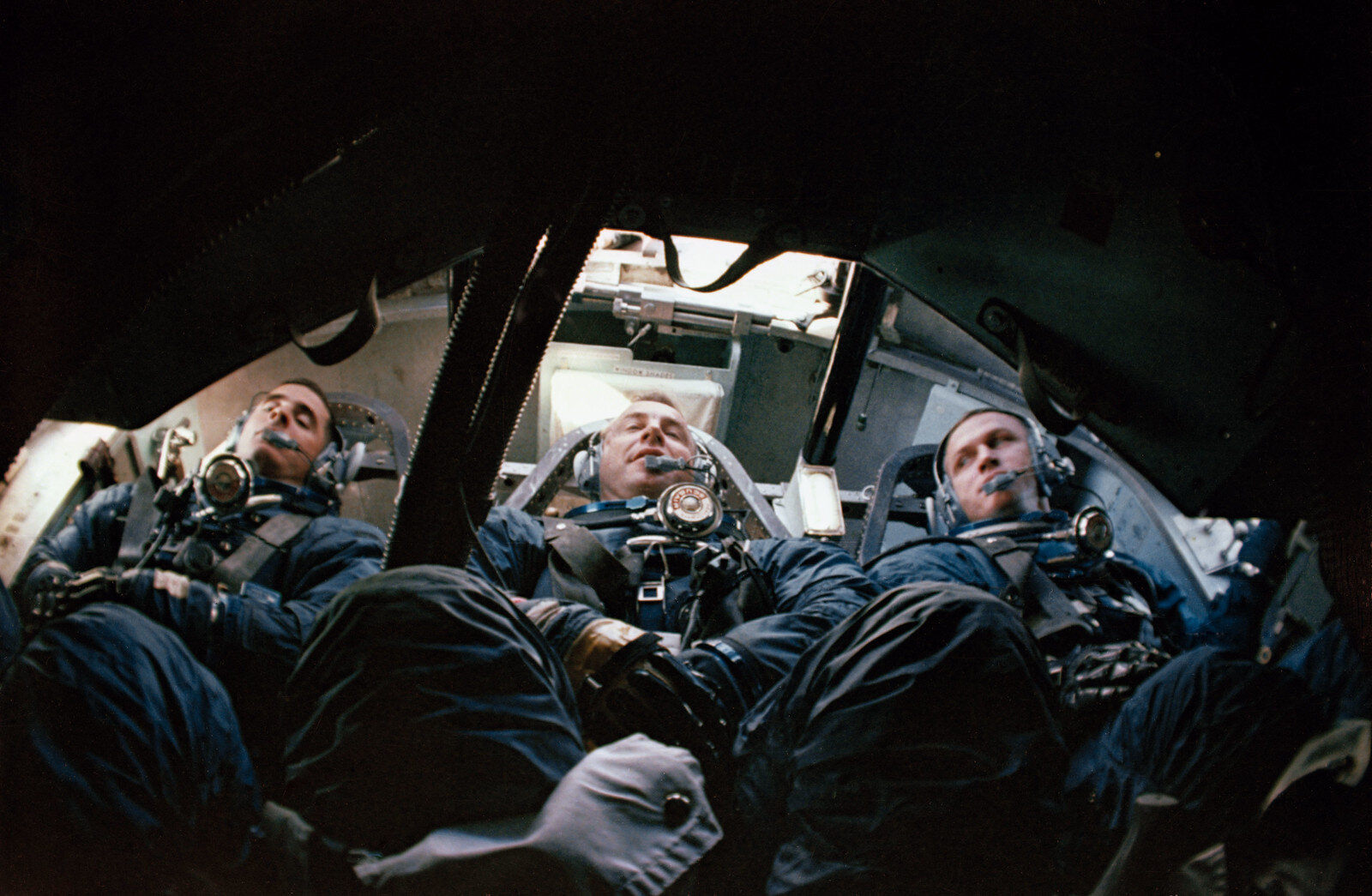NASA .jsc
& .gsfc
For the seminal 50th anniversary of Apollo 8’s trip to the Moon—the first time humans had been further than low-earth orbit in our entire history—I researched and wrote a five-article series, searched the NASA archives for original photos from the era, and produced a video to accompany the third article and to promote the event on social media. This multimedia package garnered significant positive feedback online through NASA channels.
APOLLO 8
To The Moon and Back: Apollo 8 & the Future of Lunar Exploration
Muscle cars. Film cameras. Concert tees stuffed into bell-bottomed jeans. Rotary phones and 8-track tapes, TVs measured in cubic footage, crowded wallpaper. Slide rules and chalkboards and all-paper filing systems and vacuum tubes. It’s 1968, and we’re sending men to the Moon.
In The Beginning There Was Liftoff
Though some may romanticize the revolutionary 1960s, they were troubled times. The year 1968 was shaped by the assassinations of the Rev. Martin Luther King Jr. and Sen. Bobby Kennedy, which fueled violent riots and antagonized already severe discord over the Vietnam War. At the advent of the television era, such conflicts played out in living rooms across the country.
The Far Side
Halfway to the Moon, on Sunday, Dec. 22, 1968, the Apollo 8 crew glimpsed Earth outside their windows from a never-before-seen vantage point, slowly decreasing in size as they cut away through the deep black. “It’s a beautiful, beautiful view,” Frank Borman said to Mission Control as the spacecraft sped onward toward its destination. (MP3, NASA audio courtesy Kipp Teague).
The Return
Following a series of well-executed re-entry trajectory corrections, Apollo 8 tore through our atmosphere at higher speeds than humans had ever moved before, culminating in what Lovell called “a real fireball” in the re-entry audio recording. Listen to the re-entry audio between Command Module Pilot Jim Lovell and Mission Control: MP3, NASA audio courtesy Kipp Teague.
The Next Epoch
Half a century ago, Apollo 8 ushered in a new era of space exploration. The missions that followed in close succession would herald these breakthroughs in science and in engineering prowess with drama and color.
This video is a montage of NASA archival footage from the Apollo 8 mission. Music: "People Can't Stop Chillin'" by Sports; used with permission. Credit: NASA.








After my time with NASA, I have stayed connected as a freelancer. I quite enjoyed a recent project for NASA Explorers: a podcast in honor of the Apollo program’s 50th anniversary. The podcast asks ordinary people how this extraordinary achievement impacted their lives and interviews NASA scientists to hear what we’ve learned from those missions and from the Moon since 1969. I created the social media art, poster art, and cover art for the podcast. Listen below.






HUBBLE SPACE TELESCOPE
Hubble Celebrates 25 Years Since First Repair Mission in Space
THE CALDWELL CATALOGUE
Caldwell Catalog: C1
This collection of stars is part of Caldwell 1, the first object in the Caldwell catalog. Also known as NGC 188, it is an open cluster, a group of stars that were all formed from the same large cloud of gas and are therefore all roughly the same age. Scientists are interested in such clusters because they can study how the chemicals in each star vary from one star to another.
Caldwell Catalog: C5
Caldwell 5, also known as IC 342, is a spiral galaxy located approximately 11 million light-years from Earth. This sparkling, face-on view of the center of the galaxy displays intertwined tendrils of glowing, rosy dust in spectacular arms that wrap around a brilliant blue core of hot gas and stars.
Caldwell Catalog: C3
Located just north of the Big Dipper, Caldwell 3 is one of at least 34 gravitationally bound galaxies in the Ursa Major galaxy group. This barred spiral galaxy, also known as NGC 4236, sits 11.7 million light-years from Earth in the constellation Draco and has an apparent magnitude of 9.6.
Caldwell Catalog: C6
This phantasmagorical sculpture of gas and dust gives one the feeling of observing a series of explosions deep under the surface of a clear body of water. Caldwell 6, also known as NGC 6543 and commonly called the Cat’s Eye Nebula, is as well known as it is enigmatic. Hubble’s stunning image of this remarkable object has garnered fame for both the telescope and the nebula.
Caldwell Catalog: C4
This beautiful, blushing nebula is unique amongst its counterparts. While many of the nebulae visible in the night sky are emission nebulae — clouds of dust and gas that are hot enough to emit their own radiation and light — Caldwell 4, otherwise known as the Iris Nebula or NGC 7023, is a reflection nebula.
Caldwell Catalog: C7
This hazy, steely blue spiral galaxy mottled with pink, flower-like gaseous regions and granular filaments of dark dust is Caldwell 7 (also called NGC 2403). The galaxy’s pinkish, glowing clouds are the energetic birthplaces of stars known as H II regions.

Women in STEM
The multimedia campaign for NASA’s Women in STEM night

Tuning in to Radio JOVE

NASA@work
NASA@work media plan
During my time at NASA’s Johnson Space Center, I worked with an internal team called CoECI to build out a media plan. Over the course of that summer, I conducted original research, constructed, wrote, and designed a complete media plan + style guide to rebrand CoECI’s sub-team, NASA@work.
NASA@work challenge winner creates novel approach for future lunar landings
Lunar Lander Challenge
I created this video to accompany the article above, a feature about a fellow intern who won a design challenge for a lunar lander subpart. At the time, I did not have a tripod, so the video is somewhat shakey.
NASA JSC Award
In recognition of outstanding performance and lasting contributions as a Summer 2018 intern








